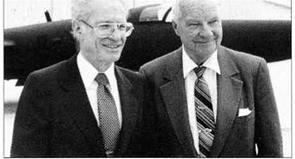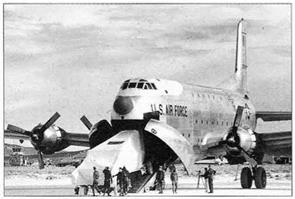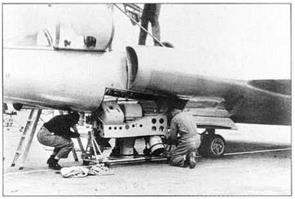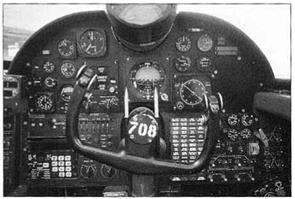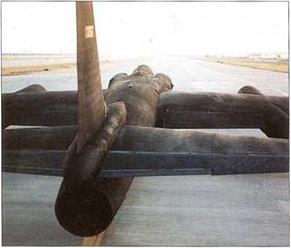LOCKHEED’S BLACKWORLD SKUNK WORKS
![]()
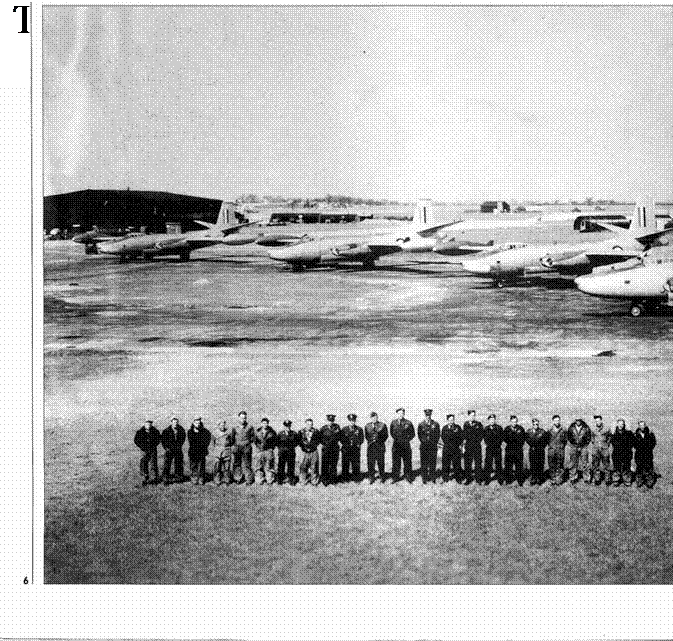
The name of an 11th Century Holy Roman
Emperor, Frederick Barbarossa, King of Germany, is etched forever in contemporary’ history.
At dawn on 22 June 1941, Nazi Germany launched Operation Barbarossa, the invasion of the Soviet Union. As its Panzer Divisions rolled east, smashing everything in their path, Soviet industry sought protection deep within the Motherland. Hitler’s maps would have been good enough to show him supply lines of a thousand miles to Moscow… When, after WWII, ‘An iron curtain… descended across the Continent’ and relations between the victorious east and western powers chilled into the Cold War, it was soon discovered that the accuracy of maps and target intelligence held by Britain and the US
was woefully inadequate. With limited human intelligence (HUMINT) being provided by agents in the field, large gaps remained in the knowledge of Soviet industrial and military capability. Stand-off aerial reconnaissance of peripheral targets provided a partial solution to the problem, but the vastness of the Soviet Union left only one option, given the level of technology available at that time – overflight. So began the so called PAROP program – Peace-time Aerial Reconnaissance Operations.
For several years such sorties were conducted utilising converted bombers manned by extremely courageous air crews. De Havilland Mosquito PR.34s flying with 540 Sqn, based at RAF Benson in Oxfordshire, conducted reconnaissance flights from altitudes in excess of 43,000 ft
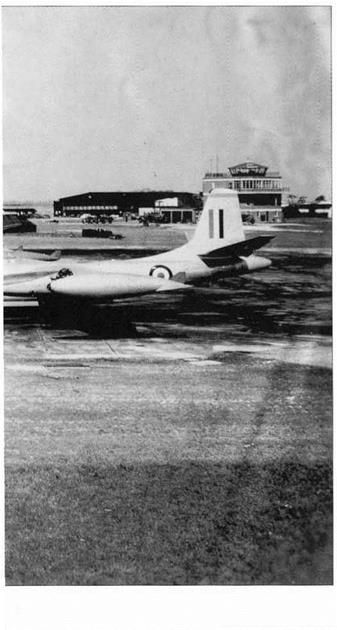 over such places as Murmansk and Archangel. Operations from such heights provided a haven from interception by Soviet fighters and continued until at least 1949.
over such places as Murmansk and Archangel. Operations from such heights provided a haven from interception by Soviet fighters and continued until at least 1949.
In June 1948, the Soviet Union enforced a food blockade upon the western zones of Berlin. The allies responded by mounting a round-the-clock airlift; the United States highlighted the seriousness of the situation by redeploying bombers back to Britain. As allied reconnaissance operations continued, it was only a question of time before such actions provoked the ultimate response. It first occurred on 11th April 1950, when a US Navy Consolidated PB4Y Privateer, operated by VP-26 and with a crew of ten onboard, was shot down and crashed into the Baltic, off Soviet Latvia.
World destabilisation esealateded when at dawn on 25 June 1950, communist North Korea invaded its southern neighbour and in so doing, sparked off the Korean War. In Europe, surveillance operations against the USSR
continued; the 5th Strategic Reconnaissance Group (SRG), from Travis AFB, operated Boeing RB-29s from RAF Sculthorpe and Burtonwood. Like the RAF Mosquitos, their high-altitude performance and long range made them ideal photographic and Electronic intelligence (PHOTINT and ELINT), gathering platforms. In February 1951, a small detachment of four RB-45 Tornados from the 91st SRG, from Lockbourne AFB, Ohio were ‘loaned’ to Great Britain, painted in RAF markings and were utilised by a mixed USAF/RAF crew on high-altitude, night time overflights of the Soviet Union and Warsaw Pact countries for nearly three years. No aircraft were lost during these nocturnal forays, however, by 1954, developing Soviet anti-aircraft capabilities made it prudent to stop using RB-45s in this role and they were transferred back to USAF control.
![]()
 |
Not surprisingly, the Soviet Union were becoming increasingly sensitive to Western incursions into its
![]() airspace and retaliated by pressing home a series of attacks on any aircraft suspected of violating its sovereignty. In April 1952, an Air France DC-4 was attacked and damaged in the Berlin corridor and less than two months later a Swedish Air Force C-47 was downed into the Baltic Sea east of Gotland. Even search and rescue PBY was attacked whilst looking for survivors; the Russians certainly meant business. Four months later, MiG-15s destroyed a reconnoitring RB-29. On 10 March 1953, a USAF F-84 Thunderjet was shot down over Bavaria by Czech MiG-15s. Two days later an RAF Lincoln (RF-531) of the central gunnery school, was shot down in the Berlin Corridor by MiG-15s; seven crew lost their lives. On 15 March 1953, an RB-50 of the 38th SRS, 55th SRW, flown by Lt Col Robert Rich was intercepted by Soviet MiG-15s. The gunner, T/Sgt Jesse Prim, returned fire and the MiG withdrew. However, on 29 July, another RB-50 from the same wing was not so lucky. Attacked by MiG-15s during a reconnaissance flight near the Soviet border, the RB-50 lost a wing and fell into the Sea of Japan. Co-pilot Capt John E Roche was the only survivor.
airspace and retaliated by pressing home a series of attacks on any aircraft suspected of violating its sovereignty. In April 1952, an Air France DC-4 was attacked and damaged in the Berlin corridor and less than two months later a Swedish Air Force C-47 was downed into the Baltic Sea east of Gotland. Even search and rescue PBY was attacked whilst looking for survivors; the Russians certainly meant business. Four months later, MiG-15s destroyed a reconnoitring RB-29. On 10 March 1953, a USAF F-84 Thunderjet was shot down over Bavaria by Czech MiG-15s. Two days later an RAF Lincoln (RF-531) of the central gunnery school, was shot down in the Berlin Corridor by MiG-15s; seven crew lost their lives. On 15 March 1953, an RB-50 of the 38th SRS, 55th SRW, flown by Lt Col Robert Rich was intercepted by Soviet MiG-15s. The gunner, T/Sgt Jesse Prim, returned fire and the MiG withdrew. However, on 29 July, another RB-50 from the same wing was not so lucky. Attacked by MiG-15s during a reconnaissance flight near the Soviet border, the RB-50 lost a wing and fell into the Sea of Japan. Co-pilot Capt John E Roche was the only survivor.
As the cost in air crew’s lives continued to mount it became apparent that a new approach to gathering such vital intelligence was needed. With high altitude having already been established as the ‘operational environment’ for such missions, it was a US Air Force Major who articulated the way forward. Having spent some time as an aeronautical engineer with Chance Vought, John Seaberg had been recalled to active duty following the outbreak of the Korean War. It was whilst serving as Assistant Chief in the New Developments Office, Bombardment Branch, at Wright Field, near Dayton, Ohio, that he mapped out high altitude strategic reconnaissance philosophy, proposing to mate an aircraft with an extremely efficient high-aspect-ratio wing to the new generation of turbo jet engines. Utilising such a union, he believed an aircraft would be capable of cruising at altitudes far in excess of any other then in service.
Spurred on by his new boss, William Lamar, Seaburg had, by March 1953, created a formal specification, requiring the aircraft to cruise at an altitude of 70,000 feet, possess a range of 1,500 nautical miles, whilst carrying a camera payload weight of up to 7001bs, to be in
|
|
Above Undoubtedly two of the world’s greatest aeronautical engineers, Kelly Johnson (right) and his protege, Ben Rich.
(Lockheed Martin)
Below Heavily shrouded for security reasons, the prototype U-2 is disgorged from а С-124 at Area 51. (Lockheed Martin)
Bottom Resplendent with ‘star and bar’ markings, prototype 001 is photographed at Area 51 during very early flight tests.
 |
(Lockheed Martin)
|
|
|
|
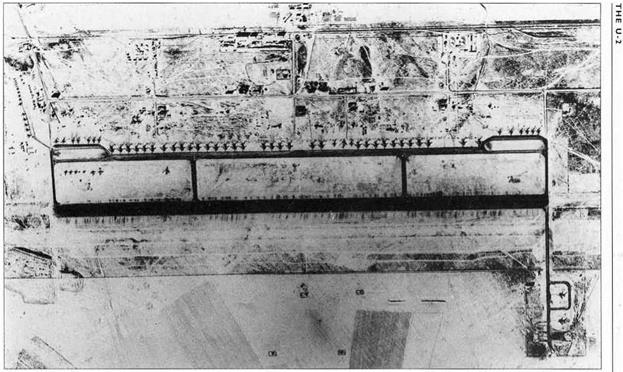 |
Above The Type A camera system consisted of three Fairchild HR-724, 24-inch cameras carried in the aircraft’s ’Q-bay’.
(Lockheed Martin)
Top This CIA, U-2 overflight of Engles Air Base, in the Soviet Union, captured 32 Myaseshchev M/4 Bisons and 30 other aircraft dispersed around the airfield. (CIA)
service by 1956. These initial proposals were subsequently released to just three of the smaller aircraft manufacturing companies; the rationale being that as large-scale production was not envisioned, the project would receive a higher priority than if placed with the larger players.
Bell and Fairchild were requested to submit proposals for the design and construction of a totally new aircraft; whilst Martin were asked to apply improvements to the
B-57 (a design built under licence by them, but actually developed by the English Electric Company and known in RAF service as the Canberra). In July 1953, six-month study contracts had been agreed with each company and the project, identified as MX-2147, was given the classified code name of ‘Bald Eagle’.
Developments in camera and film technolog)’, required to gather surveillance data from high altitude, had been proceeding in parallel with those made by the aerospace industry. Having established the Photographic Laboratory at Wright Field before the Second World War, Brig Gen George Goddard recruited two individuals, Cols Richard Philbrick and Amrom Katz, who continued in service after the war. Renamed the Aerial Reconnaissance Laboratory, Goddard also helped establish a group of optical research specialists that formed the Boston University Optical Research Centre. These included its director. Doctor Duncan MacDonald. In addition, there were notable industrialists and academics serving on various presidential panels who also played a key role in the development of high altitude reconnaissance imagery; people such as Harvard astronomer Doctor James Baker, Edwin Land, inventor of the Polaroid camera, Allen Donovan and Col Richard Leghorn, an airborne reconnaissance expert from Eastman Kodak. However, it was Jim Baker who had, by the end of WAVII, produced the first 100-inch focal length precision lens for an aerial camera. This work was continued at Boston by Dune MacDonald and his team in the early post-war years and culminated in a massive 240-inch focal length lens which, at fourteen feet, could only fit into an RB-36!
As US fears of a possible surprise Soviet ICBM attack continued to mount, the Air Force set up a study group at Boston to look further into the aerial reconnaissance
problem. Code named ‘Beacon Hill’, it was chaired by Carl Overhage, and first assembled in May 1951. Bringing together Baker, Land and Donovan, some of this team also became members of the so-called Killian committee, set up by President Eisenhower in 1954. It served under James R Killian, and would drive the decision to build a light-weight reconnaissance aircraft.
By January 1954, Bell, Fairchild and Martin had completed their studies and submitted them to Wright Field for evaluation. Apart from all three companies nominating the new Pratt & Whitney J57 axial flow – turbojet engine (with high altitude modifications, the full designation would become J57-P-37), the design submissions varied considerably. As requested, Martin’s proposed Model 294 was a big wing version of the B-57; Bell’s Model 67 was a frail-looking twin-engined craft, whilst the single-engined Fairchild M-195 featured an over-the-fuselage intake and a stub-boom mounting for vertical and horizontal tail surfaces.
By March 1954, engineers at Wright Field had nominated Martin’s B-57D as the interim design, whilst the Bell proposal was felt to be the more suitable, longer-term design. Consequently, a list of B-57 modifications was sent to Air Research and Development Command (ARDC.) Headquarters, to enable urgent Air Force intelligence requirements in Europe to be met.
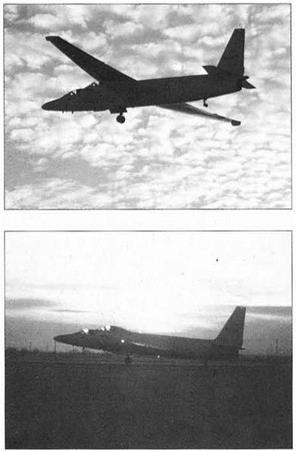
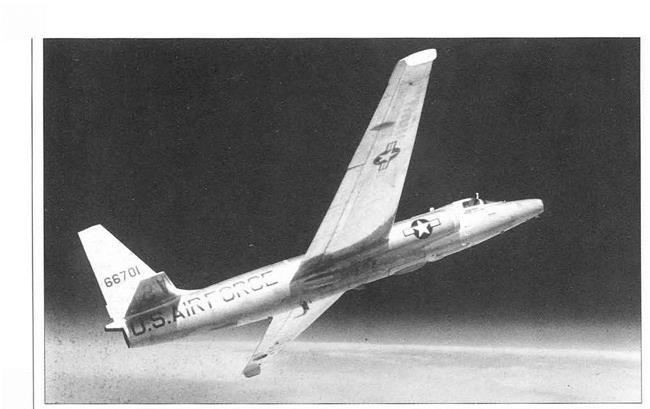 |
In April, Seaburg briefed all three designs to ARDC and Strategic Air Command (SAC). This was followed a month later by vet another briefing, this time to Air Force Headquarters in Washington DC. Shortly afterwards Seaburg received approval to proceed with the B-57D and tentative approval for the Bell Model 67; however, on 18th May an unsolicited proposal originating from Lockheed hit his desk!
It was perhaps inevitable that someone in the Pentagon would leak details of the classified high-altitude reconnaissance proposal to Lockheed’s Advanced Development Projects boss, aircraft design genius, Clarence L ‘Kelly’ Johnson. However, after a short but detailed review, Seaburg and his staff rejected the Lockheed design, designated CL-282, and in June 1954 Kelly received a letter
Left When initially delivered to the Air Force, the U-2As were operated in natural metal finish and standard markings.
(Lockheed Martin)
Middle left and bottom left Starting life as a U-2A, Article 393 was converted to a dual control U-2CT trainer in 1973.The elevated second cockpit was accommodated in what was formerly the Q-bay. (Paul Crickmore)
Right In the cramped confines of early U-2 cockpits, partial pressure suits were worn. Here NASA pilot Jim Hoyt undergoes a check in his S100 suit. (Paul Crickmore)
Below Unusually for a military aircraft of its size, the U-2’s ailerons and elevators are controlled via a yoke.
(Lockheed Martin)
officially rejecting his proposal. Undaunted, Kelly decided to pursue funding from alternative sources. Shortly afterwards he therefore presented a refined design submission to a Central Intelligence Agency (CIA) study committee.
![]()
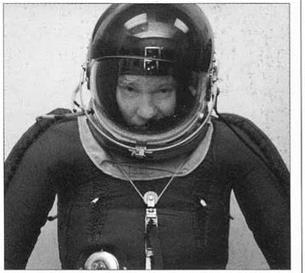
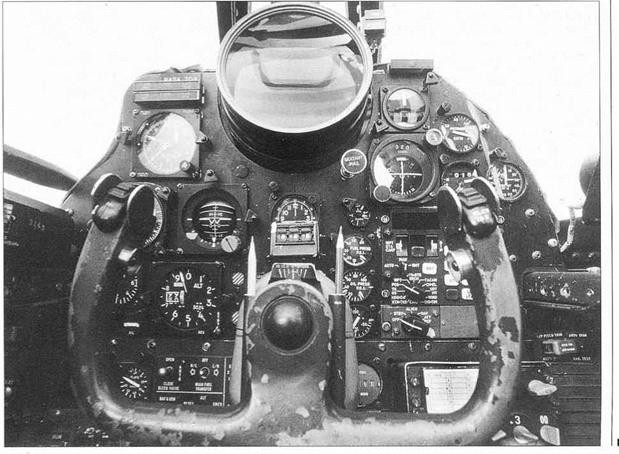 |
With the Killian Committee having been briefed earlier on all four ‘Bald Eagle’ contenders and the CIA becoming increasingly enamoured of the idea of establishing its
![]()
 |
Above Type A system, three Hycon HR-73224 cameras.
own airborne reconnaissance capability, Kelly met with the Government Advisory Board on 19 November 1954. During the course of that meeting he was told that he… “was essentially being drafted for the project”.
The Killian Committee’s decision to back the refined CL-282 proposal was communicated to Secretary of Defence, Charles Wilson and CIA Director, Allen Dulles. They subsequently briefed President Eisenhower and sought authorisation for a programme to produce twenty aircraft at a total cost of 835 million. This was duly sanctioned.
A day later Dulles recruited Richard Bissell (a brilliant economist who lectured at both Yale and MIT), to manage the programme. That same day, Kelly received a phone call giving him the go-ahead for project ‘Aquatone’. Within days, Lockheed’s ADP office, better known as ’the Skunk Works’, had by default become a full-scale, advanced design, engineering and production facility. The requirement for absolute secrecy meant that in the years ahead, the Skunk Works team were assured a high degree of autonomy from the rest of the Lockheed Corporation; additionally, the high level of specialised support required to run the programme, coupled with the lack of CIA expertise in this field, ensured Lockheed’s participation in the programme for the life of the aircraft. With one decision, a series of precedents had been set for future aircraft programmes.
The Skunk Works had come into being back in 1943, following Lockheed’s successful bid to build the United States first jet fighter. Kelly recruited the finest engineers from the Burbank facility and put them to work in an area isolated and secure from the rest of the plant – building the XP-80 in just 143 days! The high level of secrecy surrounding the Facility’s activities, together with its location – adjacent to the unit’s aw’ful-smelling, plastics manufacturing plant, caused Ervin Culver, a talented engineer on Kelly’s team (who later invented the rigid rotor system for helicopters), to habitually answer the telephone using the name ‘Skunk Works’, after a location in a popular war rime comic strip, written by Al Capp – the name stuck.
The team Kelly recruited to design and build the new aircraft included Dick Boehme (project engineer), Art
Above The Itek Iris II Panoramic camera.
Viercck (head of manufacturing), Ed Baldwin and some fifty other key engineers. Kelly nominated Tony LeVier (chief test pilot on the XF-104), to be the projects chief test pilot, but his first task wras to find a secret site from which to conduct flight tests. After flying around fbr two weeks with Dorsey Kammerer, in Lockheed’s V-tailed Beech Bonanza, Tony presented a short list of three possible sites to Kelly, who chose the one at the top of the list – Groom Lake. The site fell within the boundaries of the main Atomic Energy Commission (AEC) nuclear test site. Therefore the area had been cleared, fenced off and granted a restricted airspace zone. Within three months, under the auspices of Richard Bissell, a large team of AEC construction crews worked round the clock to transform the site into a basic test facility, consisting of a tarmac runway, two hangers and a number of accommodation trailers. An additional veil of secrecy w as provided when it was agreed that all information released into the public domain would state that the aircraft had been developed as a high-altitude research tool, in service primarily with the National Advisory Committee for Aeronautics (NACA, later redesignated NASA).
To ensure that ‘Kelly’s Angel’ (as the design was being referred to by some in the Skunk Works), maintained a competitive edge over its rival, the Bell 67 (now officially designated X-16 by the Air Force as a cover), Kelly promised that his design would be airborne in no more than eight months after the first metal was cut. The initial batch of twenty aircraft wrere built at the Burbank plant, thereafter further production was moved to Oildale, near Bakersfield, California. On 15 March 1955, wind tunnel testing of the design had been successfully completed and on 21 May, the fuselage of ‘Article 34Г, the prototype, was removed from the jig. On 20 July, the completed aircraft was handed over to inspection for final checks. The next day it was disassembled and put into loading carts. At daybreak on 24 July, Article 341 was loaded into an Air Force C-124 and flown to Groom Lake, or Area 51. There it was reassembled in the semi- completed hangars and three days later static engine runs were initiated. With taxi tests completed – the third of which culminated in the aircraft inadvertently getting
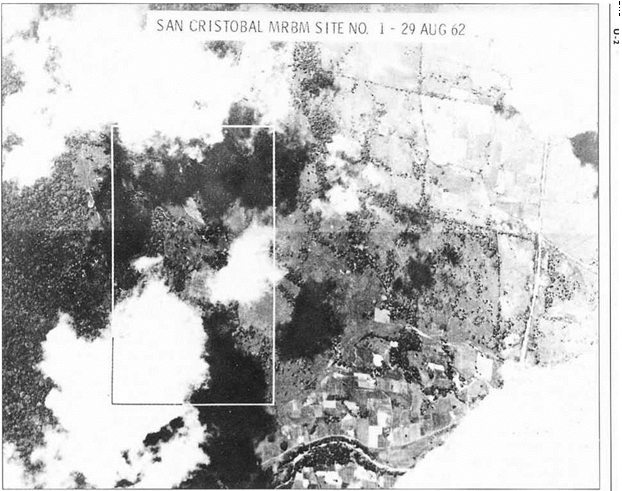 |
Above This is one of a series of shots taken by an ‘Agency’ U-2 overflight of Cuba on 29 August 1962, when concerns were raised that Soviet MRBMs had been deployed on the island.
(CIA)
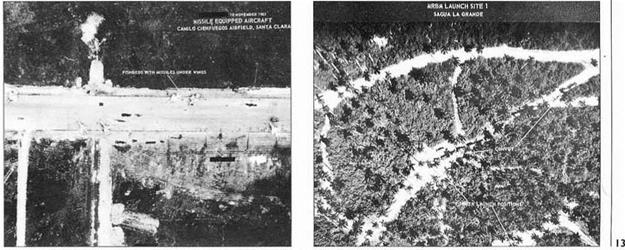 |
Below left and below right Surveillance of Cuba continued throughout the crisis, providing decision makers with vital information of the build-up and later deactivation of weapons systems. (CIA)
![]() airborne, to a height of 35ft. The first scheduled flight took place at 15:55 hrs on 4 August 1955. Witnessed by several key Skunk Works and ‘Agency’ people, Tony LeVier, (using the call sign Angel 1), was chased by a Lockheed operated C-47, flown by company test pilot Bob Matve accompanied by Kelly Johnson (Matye would be the second pilot to fly the aircraft). Kelly had insisted that Tony should land the aircraft in a nose-level-main – gear-first attitude. However, after five attempts Tony abandoned this technique and landed the aircraft, having been airborne for 45 minutes, using a conventional tail – wheel-first landing.
airborne, to a height of 35ft. The first scheduled flight took place at 15:55 hrs on 4 August 1955. Witnessed by several key Skunk Works and ‘Agency’ people, Tony LeVier, (using the call sign Angel 1), was chased by a Lockheed operated C-47, flown by company test pilot Bob Matve accompanied by Kelly Johnson (Matye would be the second pilot to fly the aircraft). Kelly had insisted that Tony should land the aircraft in a nose-level-main – gear-first attitude. However, after five attempts Tony abandoned this technique and landed the aircraft, having been airborne for 45 minutes, using a conventional tail – wheel-first landing.
It was during phase one of the flight test programme that the aircraft was officially designated U-2, the U for Utility, again designed to obscure the aircraft’s true mission. Bell’s X-16 had also been progressing well, with construction getting underway in September 1954 and its
Right The pledge given by President Eisenhower and repeated by Kennedy, that the US would conduct no more manned overflights of Soviet territory following the Gary Powers shoot down, implicitly excluded other Communist Bloc countries and the People’s Republic of China. In early 1959 the first of several cadres of Chinese Nationalist pilots arrived at laughlin to begin U-2 flying training. From I960 to 1968 these brave pilots conducted numerous overflights, gleaning vital intelligence relating to the Republic’s emerging nuclear capability – several aircraft were shot down and put on display at the Peking People’s Museum. (Paul Crickmore Collection)
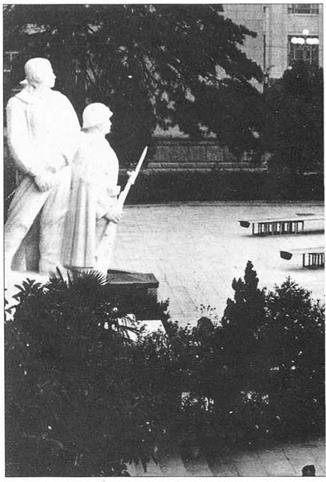
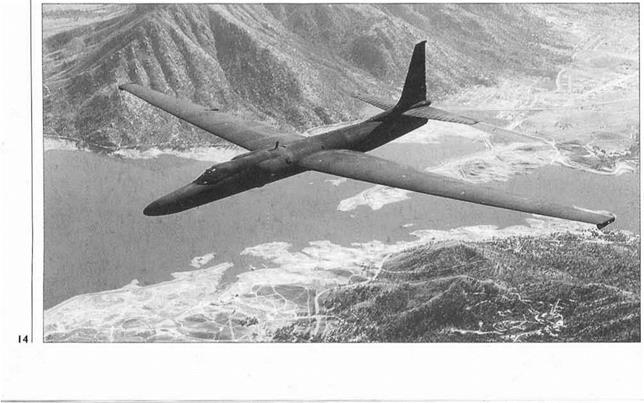
Be/ow In Late 1968, the U-2R entered service under the auspices of the Agency and was primarily employed in operations conducted by the Nationalist Chinese over the Republic of China. (Lockheed Martin)

first flight scheduled for early 1956. However, with the Agency, not the Air Force, now responsible for high-alti – rudc reconnaissance, the X-16’s raison d’etre had disappeared. Consequently, two months after the U-2 _ took to the air, a decision was made to terminate the X – 16 contract – it was a bitter blow for Bell and one that had serious financial implications for several years.
The first of six RB-57s were delivered to SAC, under Project Black Knight, in March 1956. Operated by the 40S0th Strategic Reconnaissance Wing (SRW), 4025th Strategic Reconnaissance Squadron (SRS), located at Turner AFB, Georgia, the unit conducted its first operational deployment, under Operation Sea Lion, just four months after activation. Most of these early operations were Electronic Intelligence/Signal Intelligence (ELINT/ SIGINT) missions, flown from Operating Locations (OLs), at Yokota AFB, Japan and, briefly, Eilson AFB, Alaska.
Highly classified, these ferret sorties utilised specialist equipment designated Model 320 or SAFE (Semi – Automatic Ferret Equipment), which had been tested during 1956 and 1957, under the Blue Tail Fly project; thereafter it was declared operational and deployed. In addition, the unit conducted high altitude sampling, during which particles were collected from the upper atmosphere, following nuclear tests undertaken by China
and the Soviet Union. This enabled scientists to ascertain the weapons’ characteristics: yield, efficiency etc.
In February 1957 the 4025th relocated from Turner to Laughlin AFB, Texas and one month later they received the last of twenty RB-57Ds ordered by the Air Force.
For six month, s further air sampling flights were conducted, this time from Eniwetok Proving Grounds, on the Marshall Islands. Then, in early 1959, under Operation Bordertown, the unit deployed to Europe, where they continued to conduct air sampling and ELINT/SIGINT missions, before returning to Laughlin and deactivating in mid-1959.
Back at Area 51, Tony LeVier had completed a total of twenty flights in the U-2 and on 1 September, he left Project Aquatone, having been promoted to Director of Flying, back at Burbank. Planning flight tests became the responsibility of Ernie Joiner and these were now flown by test pilots Bob Matye and Ray Goadey.
Technical Overview
The original CL-282 design submission consisted of a slightly modified XF-104 Starfighter fuselage and tail assembly, a large span high aspect ratio wing and a General Electric J73 – GE-3 non-afterburning turbo jet. However, the J73 was an unknown (and in the long run 15
![]()
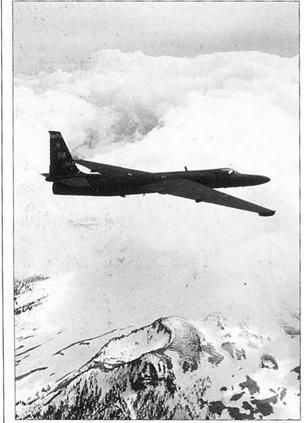
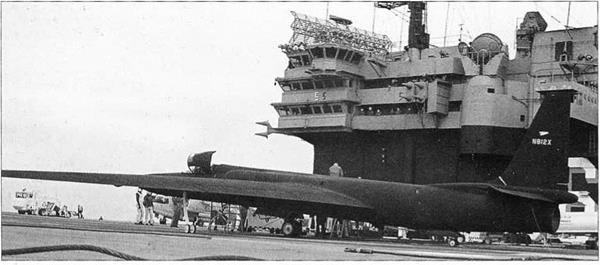
Above Bill Park carrier-qualified the U-2R aboard USS America
‘ (CVA-66) in 1969. A similar exercise had taken place in early
1964. when Bob Schumacher qualified a modified U-2, redesig-
nated U-2G, aboard USS Ranger (CVA-63). (Lockheed Martin)
Left One-third larger than the earlier U-2A/C versions, the U-
2R brought with it major improvements in mission capability,
payload capability, range and crew comfort. (Lockheed Martin)
Below Operated by NASA as an ER-2 (Earth Resources), serial 708, this aircraft began life asTR-l serial 80-1069. Apparent is the more commodious cockpit. (Paul Cnckmore)
|
|
unsuccessful) power plant. Acceptance of the CL-282 design concept became conditional upon it being powered by the J-57. During this enforced redesign, the fuselage was both lengthened and widened to accommodate the new engine. The F-104 ‘T’ tail was replaced by a conventional unit and the cockpit pressurised.
To achieve the required operating altitudes, the design was aerodynamically clean and the quest for weight reduction almost obsessive – the aircraft’s unladen weight being just 12,000 lbs. Conventional flight control surfaces on the U-2 consisted of ailerons with a travel of 16 degrees up and 14 degrees down; elevator that travelled 30 degrees up and 20 down and a rudder that deflected 30 degrees left and right. Due to wing flex, the flaps are segmented into four sections on each wing and are actuated to a maximum of 35 degrees down by two hydraulic – motors, interconnected b a flexible synchronisation shaft. Integral with the flap system is the U-2’s unique gust
control system, this enables both ailerons to move 10 degrees and the Haps 4 degrees simultaneously when flying through turbulent air or when cruising at higher speeds in smooth air.
The U-2A’s single Pratt & Whitney J57-P-37 non afterburning turbojet produced 10,500 lbs of thrust at take off and 8,100 lbs at normal cruise. This axial flow, dual compressor unit featured a nine-stage low pressure assembly followed by a seven-stage high pressure unit.
Air was then supplied to the can annular combustion chamber, where a special low v apour pressure kerosene, developed by Shell Oil, designated LF-1A by Lockheed and JP-TS (for Thermally Stable) by the military, was ignited in eight burner cans (two spark igniters were located in cans 4 & 5 and ignition in the remaining cans was achieved utilising connecting flame tubes). The gas stream then entered the turbine section, the first stage being used to drive the high pressure compressor via a hollow shaft; the second and third turbine stages driving the low pressure compressor via a concentric shaft located through the hollow, high pressure compressor shaft. A gear box, driven off the high pressure compressor shaft, provided power for the starter, tachometer, fuel pump and fuel control unit. The turbine high velocity gases were then discharged through a fixed area exhaust nozzle.
As payload weights increased, in 1958 it was decided to uprate the U-2’s propulsion system to the Pratt & Whitney J75. The two variants of this engine, the J75-P – l. iA and the later J75-P-13B, increased available take-off thrust to 15,800 lbs and then to 17,000 lbs, for normal cruise thrust this increased to 13,900 lbs, then to 15,100 lbs respectively.
The U-2 has both an AC and a DC electrical system. The AC system is provided by a 750-YA inverter for normal operation with an additional 750-YA inverter as back up. In emergencies a 100-VA inverter and a 10-KYA engine driven AC generator arc provided. DC power is produced by one 400 amp, 28 volt, engine-driven generator. A 35 amp/hour, nickel cadmium battery prov ides emergency DC power. Should the main generator fail in latc-build aircraft, a single AC/DC generator, backed up by an AC alternator driven from the hydraulic system, provides power to all essential equipment. The hydraulic system is a constant 3,000 psi pressure type, incorporating an accumulator and self-regulating engine-driven pump. The air-charged accumulator stores pressures for peak demands, thus reducing fluctuations in pump loading. It operates the landing gear, speed brakes, wing flaps, fuel boost pump drive motor; and on the U-2F, the latch reciprocal mechanism on the air refuelling system (on late model aircraft this system also operates the pitch trim and spoilers).
Retracting forward, the titanium, zero track landing gear, is of bicycle layout, consisting of twin main and tail wheels. Pogos, or outriggers, are located under each wing at about mid-semi-span, to provide support during ground handling; these too, have twin tyres and are gravity-pull-jettisoned, shortly after the wings begin to generate lift. The main gear tyres are conventional high
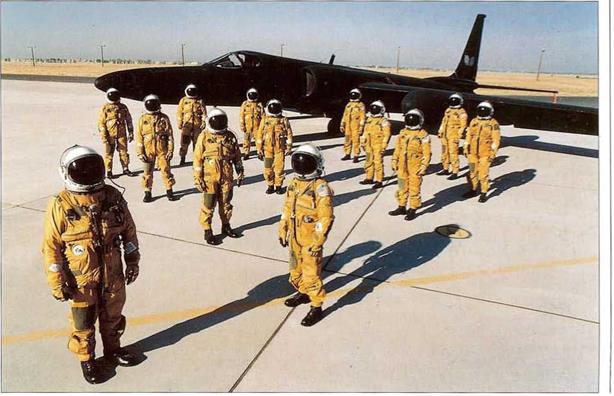 |
Below With the advent of theTR-1 /U-2R, pilots were at last able to wear full-pressure suits. This is the David Clark Company’s S1031 suit. (Lockheed Martin)
![]() pressure units, however, both the Pogo tyres and those of the tail wheel arc of solid rubber construction, requiring no inflation. Ground steering is achieved using the rudder pedals, which are interconnected by cables to the tail wheel.
pressure units, however, both the Pogo tyres and those of the tail wheel arc of solid rubber construction, requiring no inflation. Ground steering is achieved using the rudder pedals, which are interconnected by cables to the tail wheel.
The size of the U-2’s cockpit, varies significantly with variant, however, the general layout is common to all types. Perhaps the two most immediate features upon entering the cockpit are the aircraft’s control yoke (which looks as if it was stolen off the C-130 production line) and the Baird Scientific drift sight, which dominates the upper centre of the front instrumental panel. Utilising a system of mirrors and prisms, the drift sight, with its 360
|
|
Above U-2R 80-1067 lines up at Palmdale. (Lockheed Martin)
Below As the long wings get airborne, the pogos or outrigger wheels, are detached and recovered by ground support staff.
(Lockheed Martin)
degree, horizon to horizon scanning head, enables the pilot to visually check the aircraft’s ground track. A rubber cone attached to the display eliminates stray light when viewing the scope. The cockpit is pressurised to maintain an equivalent pressure altitude of 28,000ft. Although the aircraft was initially flown without ejector seats, all aircraft were later re-configured to accommodate a limited capability Lockheed-developed seat, which utilises a ‘low-g’ catapult to minimise compression injuries.
In earlier model U-2s, the mission payload was located in a cavernous, pressurised area, behind the cockpit, known as the Q4>ay. As previously mentioned, the acquisition of photographic intelligence (PHOTINT), was to be the aircraft’s primary mission. Dr Jim Baker proved to be pivotal in the conceptualisation of the camera system deployed for the U-2. Three camera systems were worked up; the Type A, was primarily refurbished Air Force stock and a stop-gap. The type C, with its 180 inch focal length lens, would be overtaken by events. However, the Type В camera would prove to be Project Aquatone’s workhorse. Optimising a 36-inch focal length lens, its large format film (18 xl8 in) was loaded on to two 6,500 foot rolls. When the system was activated, the camera imaged onto two 9.5-inch wide frames, through a single lens, thereby providing very high resolution, stereo coverage of the collection area w ith a 50-70% overlap. Manufactured by the Hvcon Corporation, the Type В camera system weighed about 500 lbs, including film.
Also located in the Q. bay was a 35mm tracker camera. This scanned from horizon to horizon throughout the flight, thereby providing the photographic interpreters with an accurate ground track of the aircraft’s flight path.











